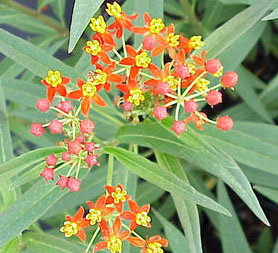PO Box 518
Bethany IL 61914
 217-542-3256
217-542-3256
Jack
Jones
PO Box 518
Bethany IL 61914
 217-542-3256
217-542-3256
MILKWEED The white sap from milkweed is used internationally to treat wart removal. Apply directly from plant or use topical creams.
Jack Jones
UPS: Address 416 West South Water St.
Bethany, IL 61914
PO BOX 518
BETHANY IL 61914
An Entrepreneur with Expertise in
Agriculture.
An Outstanding Professional for many many years.
If you have grow lights or a greenhouse available, you may want to try growing your own milkweed plants to supply your own Monarch food during the winter. Milkweed Farm has dozens of species of milkweed available, so you might want to experiment with many different kinds. You can also collect seeds from plants in the fall, when the pod is just ready to burst. If you live in the northern US, the seeds will need to be "cold-stratified," or kept in a refigerator for two to three months, before they will germinate. Many southern or "tropical" species will grow without cold stratification.
When seeds are ready to plant, plant them 1/8 inch below the soil surface using a deep pot, since most milkweeds have a long tap root. Don't plant the seeds too deep, because they need plenty of light and warmth to germinate and grow. You can fertilize them once a week after the seedling stage, using a regular flower fertilizer. Cutting back the top of the plant promotes fullness and more leaves. It takes about two months before the plant is large enough for larvae to eat. If you have a large cage, you can just put the whole plant into the cage. After the leaves have been eaten, simply cut the plant off about one inch above the soil and the plant will grow back.
Remove the seeds from the pods and place the seeds into paper envolopes and store them in an airtight container in your refrigerator. Be sure to store all your milkweed seed pods in a dry place where mice and other animals can't get into them. It is also a good idea to put a dessicant (moister remover) in the airtight container with the envelopes. Silica gel will work for this purpose. Over a long period of time, moisture will cause the seeds to rot and die.
Seeds of most temperate plants need to be vernalized, which is a fancy way of saying that they need cold treatment. The best way to give the required vernalization is through stratification. Stratification is a way of providing the seeds with the type of moist environment that favors survival of seeds overwinter in the soil. Place the seeds in cold, moist potting soil (sterilized soil is best but not required) in a dark place for several weeks or months. Since most folks aren't too keen on placing potting soil in their refrigerators, an alternative is to place the seeds between moist paper towels in a ziplock plastic bag. This works, and with the paper towel method there are fewer fungi and bacteria available to attact the seeds. After a vernalization period of 3-6 weeks or more, the seeds should be planted in warm (70o F), moist soil. Without vernalization and stratification, the percentage of seeds that germinate is usually quite low. Tropical milkweeds (Asclepias curassavica, A. physocarpa, and Oxypetalum sp.) do not require this treatment - probably because they are tropical.
Alternatively, some people have had success just soaking the seeds and planting without stratification. Put the seeds in a cup and pour hot tap water over them. Leave them in the water for 36 hours, changing the water every 12 hours with fresh hot water. After 36 hours, plant the seeds. Probably around half will germinate. Take the pots for the other half that didn't germinate and stick them in the fridge for 3 weeks. After 3 weeks, take them out and give them another 2-3 weeks to germinate. Any that haven't sprouted by then should be given up for dead.
Even after vernalization and stratification, seeds of many plant species will not germinate. In these cases, the seed coats appear to require action by physical or chemical agents to "break down" or abrade (or scarify) the seed coat. "Scarification" with some type of physical abrasion, which breaks the seed coat, usually works but soaking seeds in weak or even strong acids is needed in some cases. Scarification may be required for some milkweeds (e.g., A. viridiflora and A. latifolia) and might improve the germination rates of other species.
We prefer to start milkweed seeds indoors in Jiffy trays about eight weeks before conditions outdoors premit transplantation. To start the plants we use the Jiffy mini-greenhouses (available at Home-Depot or any nursery) and the mini Jiffy-7 peat pellets. After the pellets have been watered and have expanded to their full size, a seed is placed on the top of each pellet and then each seed is covered with a tiny pinch of excess peat moss. The mini greenhouse is covered with its clear plastic dome and is placed under grow lights or in a warm sunny window. The seeds usually germinate in 7-10 days if the flats are maintained at 70o F at a minimum . The soil should be kept moist at all times but some care is needed to keep the seedlings from getting too wet ("damping off"); such conditions contribute to fungal growth which can kill the young seedlings .
When the seedlings get their first set of real leaves, the peat pellets can be directly planted outdoors, or if it's still too early, transplanted into a pot. It helps if you add mulch around the seedlings. The mulch holds in the moisture and minimizes the growth of competing weeds. The seedlings should be planted 1-2 feet apart and fertilized 2-3 times during the growing season.
For potting soil, we normally take generic potting soil and add some sand and pea gravel. This helps the soil drain better, and if you've ever visited any railroad tracks you'll remember that milkweed has no problem growing in gravel.
If you have a choice, light soils are better than those with heavy clay. Well drained soils are generally best but there are some species, e.g. A. incarnata (swamp milkweed) and A. sullivantii, that do well in saturated conditions.
Most milkweed species evolved in open areas where they were exposed to full sunlight and they will do best if they are planted in the sunniest areas of your gardens. A few species, such as A. purpurascens, appear to require partial shade.
If you are planting seeds outdoors, you should keep in mind that all plants have a range of soil temperatures at which they will germinate. Also, remember that under sunny conditions the soil temperatures can be much higher in the daytime than the ambient air temperatures you experience. In general, it is advisable to plant seeds early, but after the last frost. Seeds planted late in the season may not germinate because of high temperatures and new seedlings can "dry off" before they are even noticed. A. incarnata (swamp milkweed) and A. syriaca (common milkweed) germinate poorly at high temperatures (>85o F) however, C. laeve (blue vine) and A. curassavica (tropical milkweed) germinate well at these temperatures. Germination outdoors depends on soil moisture and temperature and could take several weeks if conditions are not ideal.
Many plant species can be grown from cuttings but we were surprised to learn that A. curassavica can be propagated in this manner. We were under the impression that the milky sap would form a callus that would limit water uptake and formation of adventitious roots. It can, but the problem can be avoided by cutting the stems underwater and then coating the bottom of the stem with a high strength rooting hormone. The stems are then placed in vermiculite or potting soil which is kept continuously moist. Survival of the cuttings varies from 10-90% but we've been most successul when we have used cuttings of green stems (1/3 inch diameter) obtained from plants that had been fertilized two weeks prior to when we made the cuttings.
